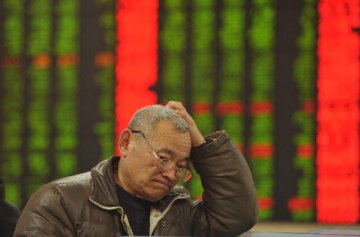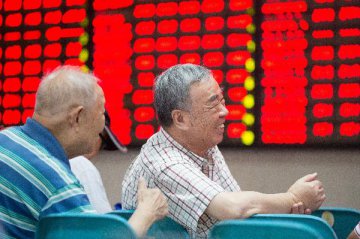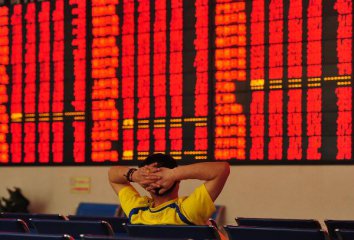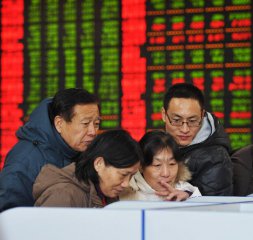
Entering December, regulators have strengthened supervision on insurance funds’ acquisitions in the secondary market. The liquidity on the market continued to be tight, and A shares face a new round of adjustment. At the same time, the Shenzhen-Hong Kong Stock Connect is officially launched and investment of pension fund into the stock market has entered the substantial stage, which also create conditions for opportunities in certain sectors. Analysts are in the view that as the number of investors going short and long are both large in the market, the market may pull back in the near term. But there are also some investment opportunities. In addition, as risks are gradually cleared out of the market, it is of high possibility that the opportunities may switch from large cap blue-chip stocks to Small and Medium Enterprise (SME) and ChiNext boards listed stocks.
Liquidity shortage limits surge of A shares
Strengthened regulation puts pressure on subject shares that were bought by insurance funds through secondary market acquisition, such as China State Construction Engineering Corporation Limited (601668.SH), and further impacted large-cap blue-chip stocks, which contribute the most to the surge of the market recently.
The liquidity condition is also not so optimistic recently. Data shows that the central bank injected liquidity of 15 billion yuan into the open market in November, significantly less than 460 billion yuan and 441.4 billion yuan that were injected into the open market. The Shanghai Interbank Offered Rate (Shibor) also continued to rise. In the global sphere, the Italy referendum result was unveiled on Dec. 5 and the “No” vote won. Analysis pointed out that this result will likely increase the further monetary easing of the EU. The latest FOMC meeting minutes also shows that most members suggested a rates hike in December.
In China, the macro economy stabilized in the near term, and the government proposes to inhibit the assets price bubble and prevent financial risk. In this context, the liquidity in November became tight. Yields of one-year, five-year and ten-year Treasury bonds in November in total rose by 13 basis points, 28 basis points and 21 basis points respectively. GF Fund Management indicated that A shares face pressure of pullback in the near term, from the perspective money supply.
The Shenzhen-Hong Kong Stock Connect was officially launched on December 5. Based on the calculation of Guotai Junan Securities, the Shenzhen-Hong Kong Stock Connect will bring incremental capital of 75 billion yuan to 150 billion yuan to the A-share market in one year. Other views say that in comparison with the circulating market value of 8.5 trillion yuan of Shenzhen Stock Exchange Component Index, the approximate 0.9 percent to 1.8 percent proportion has very limited influence to the market in the near term.
Analyst with China Merchants Securities is in the view that the scale of capital attracted by new subject shares will be limited after the launch of Shenzhen-Hong Kong Stock Connect. It is estimated that about 160 million yuan will flow to the Hong Kong market each week. Assuming other conditions remain unchanged in the near term, capitals flow into Hong Kong shares through the Shanghai and Shenzhen bourses will amount to about 3,424 million yuan. Comparing the northbound and southbound capital flows, capitals will mainly flow out of the Mainland in the medium and short term, and have negative impacts on the liquidity of the A-share market.
On Dec. 6, the National Council for Social Security Fund (NCSSF) announced that after strict evaluation, it has selected 21 securities investment management institutions for the investment of basic endowment insurance fund. It means that the investment of pension fund in the stock market has entered the substantial stage. Due to this influence, the Shanghai and Shenzhen bourses on Dec. 7 showed strong momentum, and the SSE Composite Index again stand above 3,200 points, and SME and ChiNext boards listed stocks also rebounded. Significantly, resource stocks took a lead in the surge on Wednesday, and became the major supporting force of the market. Sources from some institutions say that from the viewpoint of capital supply, tight liquidity may restrict the upward trend of the Shanghai and Shenzhen bourses, but it won’t hinder the occurrence of opportunities in certain sectors.
Fund manager of a hybrid fund in Shenzhen believes that tight capital supply may affect market sentiment, and increase the concern on the shift of monetary policy. “Liquidity itself is a kernel variable that impacts the operation of A-share market. If the liquidity or monetary policy tightened, there’s no reason for the market to rise, unless there are other strong factors, such as very solid economy or strong expectation for reform”
There are also other thoughts believe that the current asset shortage is simply short-term liquidity problem. The overall economy at present is stable, and PMI rises, thus the monetary policy is unlikely to shift.
Institutions: enter the market when SSE Composite Index stabilizes at 3,300 points
The SSE Composite Index faces huge pressure after hitting 3,300 points. Analysis pointed out that 3,300 points is a region with strong resistance. Investors may properly increase holding when stocks pulling back, and waiting for opportunities.
Some fund managers believe that for a period of time to come in the future, the stock market will not see substantial incremental capital inflows and remain fluctuating at the scope of about 30 percent. “The fluctuation of the market this year is quite repressive. In the first three quarters, the scopes of fluctuation were 20 percent, 11 percent and 5 percent respectively. More recently, it increased to 12 percent. Currently the GDP growth rate could maintain at least 6.5 percent, and the PE ratio of SSE Composite Index is about 14 times, lower than the 20 times over the past 20 years. As the valuation is low, the fluctuation is expected to continue, but the scope will be wider, and the low point will rise,” says Li Mengxia, fund manager of CR Yuanta Fund 100ETF Fund.
Why are fund managers so sensitive about the 3,300 points? Various fund managers indicated in the interview that 3,300 points is a region of previous locked plated, as well as a territory with intensive buying. When the market experienced significant pullback, many investors were trapped in the market. In addition, the region near 3,300 is also where high turnover rate occurred in the second half of last year. The pullback of the market at the beginning of this year also started from 3,300.
A public fund manager from Shenzhen told the journalist that after stabilized at 3,300, the resistance that hindered the surge of the stock index will reduce. “Lots of stocks were bought in near 3,300 points, and the national capital may also sell off at this point. After the sell-offs were digested, the region from 3,300 to 3,500 will have few previous locked plated.”
However, many people are cautious that the SSE Composite Index may stabilize at around 3,300. Source from some funds says that after Liu Shiyu, chairman of the China Securities Regulatory Commission (CSRC) criticized large-scale acquisitions by institutions in the secondary market, and the China Insurance Regulatory Commission (CIRC) suspended the universal insurance of Foresea Life Insurance, the momentum of listed companies whose company name start with “China” and concept stocks bought by insurance funds in large amount no longer exists. The market is expected to continue to fluctuate in the short term.
SME and ChiNext boards listed stocks expected to surge
Due to the speed of yuan outflow is still strictly controlled, and policies curbing the real estate market were resolutely implemented recently, capitals will look for other investment channels. Some industry insiders pointed out that the stock market is expected to see incremental capital inflows. The Main Board is likely to see valuation recovery and the SME and ChiNext boards will squeeze out the bubble of over valuation. The headwind of the SME and ChiNext boards listed stocks will gradually be digested. It is of high possibility that the highlight of the market will transfer from large-cap blue-chip stocks to SME and ChiNext boards listed stocks, and the timeframe is approaching.
Recent regulation on insurance funds may push market attention to SME and ChiNext boards. The market trend increasing from 3,100 points to 3,300 points is mainly due to insurance funds’ aggressively buying shares to a placarded threshold of 5 percent in the secondary market; superficially, insurance funds are constantly buying, and under a situation that risk preference and asset allocation logic have not changed, big blue chips and “Chinese-funded” stocks previously being invested by insurance funds are expected to face difficulties in gaining favorable performance in the post-market, which may adjust and fluctuate, based on some analysis.
The turnover of ChiNext Board is still active now, with no previous locked plated above, and investors should hold the opportunities, some fund manager thought. “The position of 2,100 points on ChiNext Board is relatively safe, and investors can deploy in some targets with favorable performance, merging activity and valuation.”
The Main Board is stronger than ChiNext Board, and such trend has already lasted for quite a while with big deviation; therefore, the latter will further increase in the future, some institutions believed.
ChiNext Board is likely to present a reversed trend recently, and it has many advantages compared to Main Board, according to the mixed fund manager in Shenzhen mentioned above. “ChiNext Board had fully experienced turnover in the second half year of 2015 and the first half one of 2016, and its index also has fluctuated between 2,100 to 2,200 points for over a half year; currently, the overall valuation is not cheap, but the risk has already been entirely released, valuation of many high-growth stocks has reduced remarkably, which are very worthy of investment.”
The valuation of SME and ChiNext boards 100 index is low, only 32 times, and the historic level has been 44 times since 2010, Li thought. This index selects the stocks with weighted average of 1:1:1 based on average market value, average floating market value and average turnover, and growth and value stocks ranking in the first 100 on the said two boards are selected to form constituent stocks of this index, with computer, medicine, media and others taking up a high proportion. Growth and value stocks are both expected to bring in opportunities in next year, and investors could allocate them.
The said index has been launched on June 29, 2007, and outperformed other three indexes, including SSE composite index, SZSE component index and CSI300 index, in nearly a decade since its launch, Huang Ping, investment director of Guli Fund, introduced. In other words, China’s economic growth in the past decade majorly came from stocks of SME and ChiNext boards. “In the future, enterprises listed on these two boards are the main drive to China’s economic growth.”
Translated by Adam Zhang and Jelly Yi























Latest comments